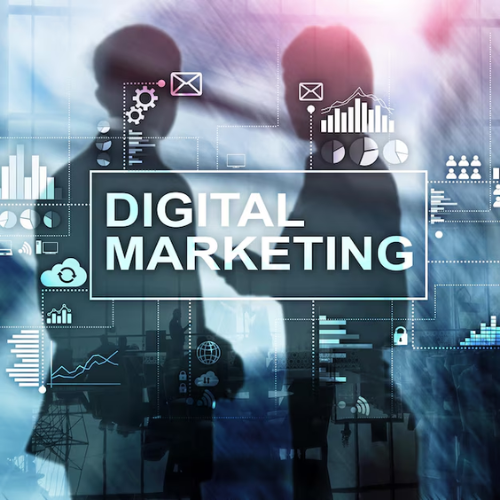In the digital space, firms have the potential to stand out from the crowd. The perception that online marketing is a simple thing to do is mistaken. There are countless techniques and tools that can confuse newbies.
So is it truly difficult to conduct online? It is true that this kind of advertising can reach more people, but there are also complexities to mastering it. Search engines and social media, for example, each need their own methods and specialists.
What Is the Meaning of Online Advertising?
Online advertising is the use of the Internet to market and sell products and services. Blogs, social media platforms, email, and search engines are all used in targeting specific segments.
Boosting Search Engine Positioning
Search engine optimization (SEO) makes your website easier to find on search engines. Good SEO requires researching keywords, improving web pages, and building links. Your aim is to create top-notch content so that people and search engines like it.
Using Social Networks for Marketing
The platforms of the social media sites like Facebook, Instagram, and Twitter give you an opportunity to talk to your audience. Share content that is exciting and relevant and do it regularly to ensure participants in your site are entertained with your posts. Use analytics information to improve the plan based on user reactions.
Publishing Content
Providing useful information creates trust among your audience. Blog posts, videos, and infographics offer resources that motivate interaction. Share these pieces on different platforms for wider reach.
Email Marketing
Email marketing lets you send tailored messages to potential and existing customers. Segmentation should be based on individuals’ behavior as well as preferences in order to customize the approach for every user group.
Pay-Per-Click Advertising (PPC)
PPC gives instant visibility on different search engines/social media platforms. You create ads and pay while each click is counted. For maximizing the ROI, you need efficient targeting techniques as well as good ad content.
Strategies to Master Digital Marketing
Set Clear Goals
Establish specific and measurable objectives that will steer your marketing endeavors, such as boosting the number of visitors to your website or increasing sales figures.
Know Your Audience
To create effective marketing messages that resonate with your audience, examine their demographics and preferences. Develop buyer personas based on this information.
Utilize Analytics
You should track marketing metrics performance using tools such as Google Analytics where available insights can be analyzed for strategy improvement over time.
Stay Updated
The digital environment keeps changing so should regularly follow news/trends attending webinars reading articles or joining forums about current issues in Digital Marketing sectors.
Test and Optimize
Try different methods out there A/B testing is useful here in evaluating both strategies hence optimizing them based on their results obtained.
These strategies being used show how accessible digital markets can be learned expanding skills at these sectors which enhances promotion capabilities within this type environment.
Key Components of Digital Marketing
Digital marketing includes various parts for online promotion. Knowing them is key for success.
Search Engine Optimization (SEO)
SEO helps your site be seen on search engines. Use keywords to guide search engines to your content. Optimize title tags, and descriptions, and create backlinks. Monitor your progress with Google Analytics. Regular updates keep your content fresh. For local businesses, focus on local SEO.
Content Marketing
Content Marketing makes useful stuff that gets people interested. This shows you know your stuff. Find out what your audience likes, like blogs radio, r, or videos. Create great content that helps them.
Create a calendar for topics and deadlines. Regular posting keeps your audience engaged. Share content on social media for a wider reach. Look at likes and comments to see what works. Change your strategy based on feedback. Valuable content brings traffic and leads.
Social Media Marketing
Use Facebook, Instagram, Twitter, and LinkedIn to engage the audience. Find out where they are. Set a regular posting schedule. Share promotions, education, and user-created content. Use images and videos to attract attention. Build connections through comments and messages. Use ads to reach more people. With social media, increase your visibility and bring people to your site.
Email Marketing
Email is a cheap way to reach customers. One way to get on the right level with people is to send them customized emails. Collect the emails of people who visit your website or use your social media accounts. Make sure the information they provide is not used in any other way but to send the messages to them. Provide discounts or exclusive content as a reward.
Divide your email list into different segments based on the behavior of users and their interests and then send tailored messages to each segment in order to obtain better replies. In each email, add a clear call-to-action that invites the readers to carry out the desired action. Ensure that you regularly monitor the open and click rates as a way of gauging the performance. Strategically designed emails not only nurture but also convert leads effectively thus making it a convenient, simple effortless task.
Pay-Per-Click Advertising
The paid search advertising is an immediate way to appear at the top of search engine result pages and on social media. The main advantage of sending direct traffic is that the targeted audience will bring instant traffic to your site. The process of preparing is to look for keywords, write an ad that sells the benefits, simple ad and easy to understand, budget management, continuously tracking costs and click rate, and both interesting and profitable though potential customers are considered based on demographics and interests. In addition, different ads should be tested to find the most efficient one.
Is Digital Marketing Easy?
The world of online advertising has its challenges, yet it has its advantages too. It becomes less complicated when one possesses the foundational knowledge and enough resources at hand.
The Learning Curve
Mastering digital marketing involves different areas like SEO, content marketing, and social media tactics. Initially, grasp the basics before moving to advanced skills. Online courses and tutorials simplify learning. Regular practice raises skills. When starting, you may find it overwhelming, but breaking it down builds confidence. Joining online communities fosters sharing experiences and tips. Begin with specific strategies that lead to effective learning. Eventually, the process becomes easier as you become familiar.
Tools and Resources Available
Digital marketers have a variety of tools available. Analytic, content creation, and social media management platforms are all helpful. Google Analytics tracks website performance. Hootsuite manages social media. Canva designs visuals. There are constant updates improving these tools. Blogs, webinars, and online courses offer education. Most platforms allow free trials to explore options without great expense. Using these resources pushes through challenges to complete marketing campaigns successfully.
Common Misconceptions
Many people wrongly believe that digital marketing is simple and painless. In fact, it necessitates careful planning, originality, and determination. The notion that success is instant is also false. Genuine development takes time with trials and adjustments involved in perfecting strategies. Contrary to belief, small businesses can also excel in digital marketing through customized approaches. One post will not lead to outcomes instead there has to be continuous strategic actions for engagement. When one recognizes these falsehoods, they will have more realistic expectations in their digital marketing endeavors.
Challenges in Digital Marketing
There are several hurdles faced in digital marketing that influence its overall effectiveness. Grasping these challenges prepares one sufficiently.
Keeping Up with Trends
It is crucial to stay current with digital marketing trends since platforms keep on altering incessantly by introducing new characteristics and algorithms. To illustrate, social media algorithms test content visibility while search engines keep on changing ranking requirements hence marketers’ strategies should change too in order to remain relevant. Reading industry blogs, attending webinars and participating in workshops enhance knowledge. Online communities offer insights into emerging trends. Following digital marketing influencers provides updates on significant changes. There must be continuous learning so as to adapt to shifts in the landscape effectively.
Technical Skills Required
You need some technology skills when working online. For instance, knowing Search engine optimization (SEO) makes it easier for your content to be found on the web. You can also use web analytics tools to check how your campaigns are performing. Based on that, tools like Observing & analyzing Google Analytics help you analyze the campaigns performance. Social media advertising requires skills to engage many online users. Managing websites goes with skills in content management systems. With email marketing, you need the right platform to reach’ a target audience effectively. Initially, learning these skills can be hard. However, you can make use of online tutorials and courses to learn gradually. As you put in more practice time, your marketing results tend to improve.
Resource Allocation
You must manage resources well in digital marketing to succeed. However, sometimes budget constraints can limit what is spendable on marketing efforts. Therefore, make a budget which includes cost of tools, advertising and personnel expenses. For example, whether you are investing in SEO tools, social media advertising or not. Time is also another important resource which needs proper allocation based on different campaigns. Ensure priority is given to key projects at any given time. Use project management applications that help to track tasks and their due dates easily as well as assess performance objectives so as to analyze return-on-investment accurately. Periodically review resource allocation strategy leading towards improved overall digital marketing results.
Tips for Success in Digital Marketing
Setting Realistic Goals
Use the SMART system. Have specific goals. Make sure goals are measurable. Choose achievable goals. Ensure goals are relevant. Set timed deadlines. Break big goals into smaller chunks. Check progress regularly. Adjust as needed.
Leveraging Analytics
Use Google Analytics to track website data. Find out how many visitors you have. Check where they come from. Find out which pages work best. Set up KPIs such as click-through rates. Use data to optimize campaigns.
Continuous Learning
Stay updated on marketing trends. Read blogs or take online courses. Join groups to learn from others. Spend time each week learning something new. Test new ideas in your campaigns. Keep improving your skills to stay ahead.
Troubleshooting Common Issues
Knowing common problems improves your digital marketing strategies. Identify issues to reduce negative impacts on campaigns.
Low Engagement Rates
Low Engagement Rates indicate disconnect between content and audience interests. Check content and ensure alignment with audience. Use polls or surveys for feedback. Use catchy headlines and images. Respond quickly to comments.
Analyze post timing. Use analytics to find when audience is active. Try different formats like videos and live streams. Use A/B testing to refine approach based on responses.
Reassess distribution channels. Focus on platforms where audience is. Customize posts for each channel to enhance relevance and increase engagement.
Poor Conversion Metrics
Poor Conversion Metrics mean difficulties turning interested visitors into customers. Check landing pages for clarity and effectiveness. Make CTAs noticeable. Minimize form fields.
Review targeting strategies. Use audience segmentation for personalized messages. Explore retargeting for users who did not convert.
Look at your website’s user experience. Are there problems with moving around the site or slow loading? Use heatmaps to see how users act and where improvements are needed. Make checkout easy by streamlining steps.
Making Content Can Be Challenging
Sometimes, we can’t think of new content because of a lack of inspiration or time. Make a content calendar for planning topics. Find out what trending topics are in your industry to get fresh ideas.
Look for popular search terms that your audience types in. This will help you create content that answers their questions. Ask your teammates or specialists in the industry for different insights.
Set aside time regularly for brainstorming and writing. Break larger projects into smaller tasks to feel less stressed. Better to have fewer high-quality pieces than too many low-quality ones.
Make sure that the old content you have is still useful by checking it often. Update wrong or old information with new data so they stay interested. Use audience feedback to adjust your writing style as needed.
Final Thoughts
Digital marketing is not that easy but the rewards that you can reap can be really good yet, of course, it can also be be a very bouncy ride. Still, learning carefully selected philosophies together with having a big of a picture in mind on the newly shinny areas that surround like snakes in the grass will get you to your destination smoothly.
Look for Software as problems to be solved and solutions created. The key to web marketing success lies only in the scope of your creativity, focused plans, and scope of improvement especially, the latter must be kept as Your goal has to be reached with your sincere efforts and exact techniques because still, nothing can be So you need to really buckle down to create your own attention getter. And promote it as much as you can for the world to notice.
Common Questions
Why is SEO vital for web marketing?
SEO is the benchmark to ensure that people see your website on search engines. This is all about SEO bringing people that are your potential customers to your business, which becomes easier for new people to then find you.
What do we mean by email marketing?
Email marketing is the art of interaction with the customers by sending personalized emails. The development of long-term relationships through targeted campaigns, and the cost-effective promotions of the brand, the product, or the service, the sharing of news, and the call to action are the activities done by email marketing.
What are the challenges of digital marketing?
Adapting to changes in the ever-changing environment is one big challenge. If you also add on top of these issues of time and human resource management and the unfailing presence of the machine (i.e. the computer), you can buy yourself a ticket or rather spend some time learning new ways of performing a task, trying out a new application, or doing whatever else might help you become more productive and efficient.
How can I set goals for my digital marketing campaigns?
Focusing on being SMART while setting your goals increases the efficiency of various marketing activities being performed and goes in line with the company’s set goals.
What are the tools that are the best support for digital marketing?
Use Google Analytics in tracking and Hootsuite in social media management, and also rely on keyword research platforms. Having the right tools is important as it makes possible campaign management as well as getting an insight into the market.
How can low engagement rates be fixed?
The right technique to enhance the levels of engagement lies in defining the relevancy of the content to the audience, using insights to decide the time for posting and diversifying content formats. Implementing these variations regularly is a sure way to go.
What’s a surefire way on your opinion to increase conversion efforts efficiency?
Take a look at the design of your web pages and the types of actions which you ask the visitors to take. Improve the user experience on your site. You will witness an increase in the conversion of finders to buyers, and hence, spend less on paid advertisements.





